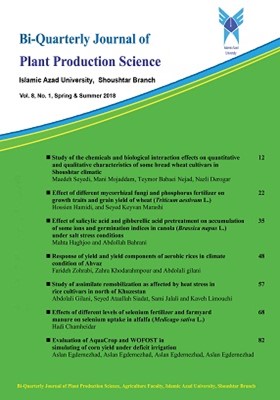Effect of different mycorrhizal fungi and phosphorus fertilizer on growth traits and grain yield of wheat (Triticum aestivum L.)
Subject Areas : agronomyHossien Hamidi1,2 1 , Seyed Keyvan Marashi2* 2
1 - 1- Department of Agronomy, Khuzestan Science and Research Branch, Islamic Azad University, Ahvaz, Iran
2- Department of Agronomy, Ahvaz Branch, Islamic Azad University, Ahvaz, Iran
2 - 2- Department of Agronomy, Ahvaz Branch, Islamic Azad University, Ahvaz, Iran
Keywords: Grain yield, leaf area index, total dry matter, root dry matter,
Abstract :
In order to investigate the effects of different mycorrhizal fungi and phosphorus fertilizer on growth traits and grain yield of wheat, an experiment was conducted in factorial experiment in a completely randomized design with three replications. The first factor included mycorrhizal fungi application as non-use of fungi (control), Glomus intraradices, Glomus mossea and Glomus fasciculatum and the second factor included various levels of phosphorus fertilization included non-application of fertilizer (control), 40, 80 and 120 kg ha-1. The results showed that the effect of fungi, phosphorus fertilizer and interaction between the application of fungi and phosphorus fertilizer on leaf area index, dry matter, root dry matter and grain yield were significant. In all treatments of mycorrhizal fungi with increasing of phosphorous fertilizer level, leaf area index, total dry matter, root dry matter and grain yield increased. Maximum values in all studied traits were observed under the application of Glomus intraradices and Glomus mossea. Glomus mossea and Glomus intraradices at 80 kg ha-1 fertilizer level was the best condition for all traits. But in Glomus fasciculatum, the maximum of traits was obtained at 120 kg ha-1 fertilizer. In general, using Glomus mossea and Glomus intraradices can reduce the use of phosphate fertilizers, which could be a new approach to achieve sustainable agriculture.
_||_


